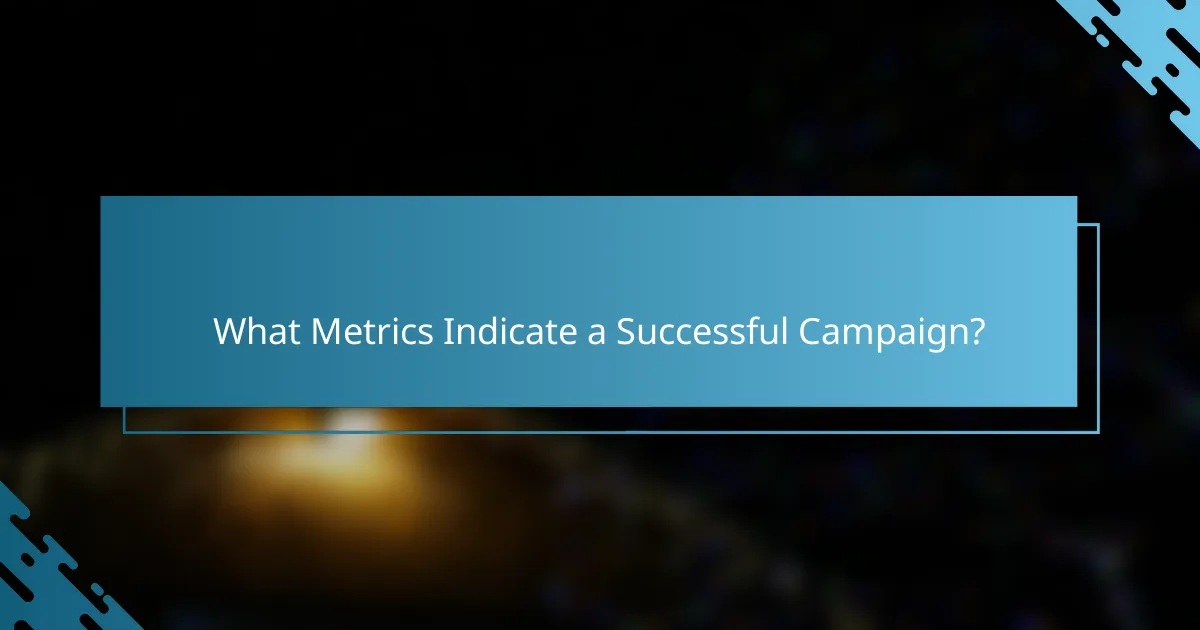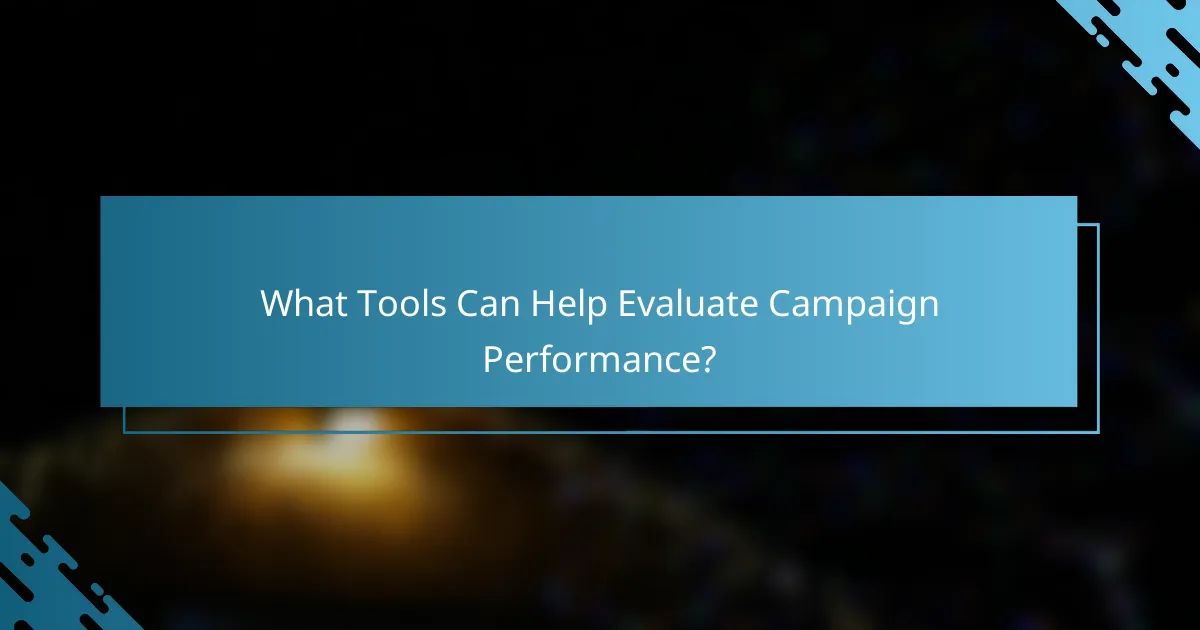Evaluating the success of social media campaigns is crucial for understanding their impact and effectiveness. By focusing on key metrics such as engagement, reach, and conversion rates, businesses can gain valuable insights that inform future strategies. Utilizing the right analytical tools allows for a comprehensive assessment, enabling companies to refine their approaches and maximize their social media presence.

How to Measure Social Media Campaign Success?
Measuring social media campaign success involves evaluating various metrics that reflect engagement, conversion, and overall impact. By analyzing these metrics, businesses can determine the effectiveness of their campaigns and make informed decisions for future strategies.
Key performance indicators (KPIs)
Key performance indicators (KPIs) are essential metrics that help gauge the success of a social media campaign. Common KPIs include reach, impressions, clicks, and shares. Setting specific KPIs aligned with campaign goals allows for targeted evaluation and clearer insights.
For instance, if the goal is to increase brand awareness, tracking reach and impressions would be crucial. Conversely, if the focus is on driving sales, metrics like clicks and conversions become more relevant.
Engagement rates
Engagement rates measure how actively users interact with your content, reflecting its relevance and appeal. This metric typically includes likes, comments, shares, and saves, providing a comprehensive view of audience interaction. A higher engagement rate often indicates a more successful campaign.
To calculate engagement rate, divide the total engagements by the total reach or impressions, then multiply by 100 to get a percentage. For example, if a post receives 200 engagements and reaches 1,000 users, the engagement rate is 20%.
Conversion metrics
Conversion metrics track the effectiveness of a campaign in driving desired actions, such as purchases, sign-ups, or downloads. These metrics are crucial for understanding the return on marketing efforts. Common conversion metrics include conversion rate, cost per conversion, and total conversions.
For example, if a campaign generates 50 sales from 1,000 visitors, the conversion rate is 5%. Monitoring these metrics helps identify which campaigns are most effective at achieving business objectives.
Return on investment (ROI)
Return on investment (ROI) measures the profitability of a social media campaign relative to its costs. Calculating ROI involves comparing the revenue generated from the campaign to the total expenses incurred. A positive ROI indicates a successful campaign, while a negative ROI suggests the need for adjustments.
To calculate ROI, use the formula: (Net Profit / Cost of Investment) x 100. For instance, if a campaign costs $1,000 and generates $5,000 in revenue, the ROI would be 400%.
Brand awareness metrics
Brand awareness metrics assess how well your audience recognizes and remembers your brand. These metrics can include brand mentions, search volume, and social media followers. Increased brand awareness often correlates with higher engagement and conversion rates over time.
Tools like Google Trends or social listening platforms can help track brand mentions and search interest. Regularly measuring these metrics allows businesses to refine their messaging and improve overall brand visibility.

What Metrics Indicate a Successful Campaign?
Successful social media campaigns can be evaluated through several key metrics that reflect engagement, reach, and overall impact. By analyzing follower growth, post reach, click-through rates, and customer feedback, businesses can gain insights into their campaign effectiveness and areas for improvement.
Follower growth
Follower growth measures the increase in the number of users following your social media accounts during a campaign. A steady rise in followers indicates that your content resonates with the audience and attracts new viewers.
To assess follower growth, compare the number of followers at the start and end of the campaign. A growth rate of 10-20% is often considered strong, depending on the industry and campaign duration. Avoid buying followers, as this can harm engagement rates and brand credibility.
Post reach
Post reach refers to the total number of unique users who see your content. High reach indicates effective distribution and visibility of your posts across social media platforms.
To evaluate post reach, track the reach of individual posts and the overall campaign. Aim for a reach that is at least 50% of your follower count, as this suggests that your content is being shared or engaged with beyond your immediate audience.
Click-through rates (CTR)
Click-through rates (CTR) measure the percentage of users who click on a link within your post compared to the total number of users who viewed it. A higher CTR indicates that your content effectively encourages users to take action.
To calculate CTR, divide the number of clicks by the total reach and multiply by 100. A CTR of 2-5% is generally considered good for social media campaigns, but this can vary by industry and platform. Focus on crafting compelling calls-to-action to improve this metric.
Customer feedback
Customer feedback encompasses comments, reviews, and direct messages from users regarding your campaign. Positive feedback can enhance brand reputation, while negative feedback provides valuable insights for improvement.
Monitor feedback through social listening tools and engagement metrics. Aim to respond to comments and messages promptly, as this fosters a sense of community and shows that you value customer input. Regularly analyze feedback trends to adjust your strategy accordingly.

What Tools Can Help Evaluate Campaign Performance?
Evaluating social media campaign performance requires effective tools that provide insights into engagement, reach, and conversion metrics. Utilizing the right platforms can help you analyze data and make informed decisions to enhance future campaigns.
Google Analytics
Google Analytics is a powerful tool for tracking website traffic and user behavior, making it essential for evaluating social media campaigns. It allows you to monitor how visitors from social media interact with your site, providing insights into conversion rates and user engagement.
To effectively use Google Analytics, set up goals that align with your campaign objectives, such as newsletter sign-ups or product purchases. Regularly review reports on traffic sources to understand which social platforms drive the most valuable visitors.
Hootsuite
Hootsuite is a social media management platform that offers robust analytics features to evaluate campaign performance across multiple channels. It provides insights into post engagement, audience growth, and overall reach, allowing you to assess the effectiveness of your content strategy.
Utilize Hootsuite’s customizable dashboards to track key metrics in real-time. This enables you to quickly identify trends and adjust your strategy as needed. Consider scheduling regular reports to keep stakeholders informed of campaign performance.
Sprout Social
Sprout Social is designed for in-depth social media analytics and reporting, making it ideal for evaluating campaign success. It offers comprehensive data on engagement, audience demographics, and post-performance, helping you understand what resonates with your audience.
Take advantage of Sprout Social’s competitive analysis tools to benchmark your performance against industry standards. This can help you identify areas for improvement and refine your campaigns for better results.
Buffer
Buffer is a user-friendly social media scheduling tool that also provides analytics to evaluate the performance of your posts. It tracks engagement metrics such as likes, shares, and comments, giving you a clear picture of how well your content is performing.
To maximize Buffer’s effectiveness, regularly analyze the performance of different types of posts and optimal posting times. This can help you refine your content strategy and improve engagement rates over time.

What Are the Best Practices for Social Media Campaigns?
The best practices for social media campaigns focus on setting clear goals, understanding your audience, and planning content effectively. By following these guidelines, you can enhance engagement, reach, and overall campaign success.
Define clear objectives
Establishing clear objectives is crucial for any social media campaign. Objectives should be specific, measurable, achievable, relevant, and time-bound (SMART). For example, instead of a vague goal like “increase engagement,” aim for “boost post interactions by 20% over the next three months.”
Consider aligning your objectives with broader business goals, such as increasing brand awareness or driving sales. This alignment ensures that your social media efforts contribute to overall success.
Target audience analysis
Understanding your target audience is essential for tailoring content that resonates. Conduct demographic research to identify key characteristics such as age, gender, interests, and online behavior. Tools like surveys and social media analytics can provide valuable insights.
Segment your audience into groups based on shared traits or behaviors. This allows for more personalized messaging, which can significantly improve engagement rates. For instance, a campaign aimed at millennials might focus on trending topics and visual content.
Content calendar creation
A content calendar helps organize and schedule posts, ensuring consistent and timely communication. Start by outlining key dates, such as product launches or holidays, and plan content around these events. This approach keeps your messaging relevant and aligned with audience interests.
Include a mix of content types, such as promotional posts, educational articles, and user-generated content. Aim for a balanced ratio to maintain audience interest. Regularly review and adjust your calendar based on performance metrics to optimize engagement.
